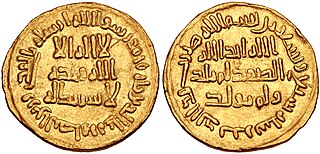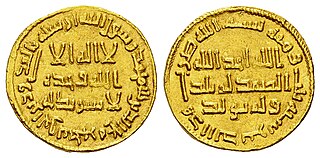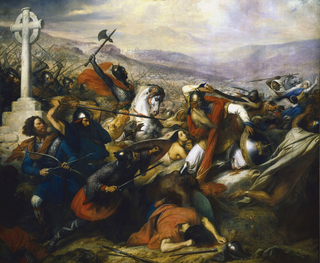
Year 714 (DCCXIV) was a common year starting on Monday of the Julian calendar. The denomination 714 for this year has been used since the early medieval period, when the Anno Domini calendar era became the prevalent method in Europe for naming years.
The 720s decade ran from January 1, 720, to December 31, 729.
The 710s decade ran from January 1, 710, to December 31, 719.
The 680s decade ran from January 1, 680, to December 31, 689.

Year 721 (DCCXXI) was a common year starting on Wednesday of the Julian calendar. The denomination 721 for this year has been used since the early medieval period, when the Anno Domini calendar era became the prevalent method in Europe for naming years.

The Umayyad Caliphate or Umayyad Empire was the second caliphate established after the death of the Islamic prophet Muhammad and was ruled by the Umayyad dynasty. Uthman ibn Affan, the third of the Rashidun caliphs, was also a member of the clan. The family established dynastic, hereditary rule with Mu'awiya I, the long-time governor of Greater Syria, who became caliph after the end of the First Fitna in 661. After Mu'awiya's death in 680, conflicts over the succession resulted in the Second Fitna, and power eventually fell to Marwan I, from another branch of the clan. Syria remained the Umayyads' main power base thereafter, with Damascus as their capital.

Septimania is a historical region in modern-day southern France. It referred to the western part of the Roman province of Gallia Narbonensis that passed to the control of the Visigoths in 462, when Septimania was ceded to their king, Theodoric II. During the Early Middle Ages, the region was variously known as Gallia Narbonensis, Gallia, or Narbonensis. The territory of Septimania roughly corresponds with the modern French former administrative region of Languedoc-Roussillon that merged into the new administrative region of Occitanie. In the Visigothic Kingdom, which became centred on Toledo by the end of the reign of Leovigild, Septimania was both an administrative province of the central royal government and an ecclesiastical province whose metropolitan was the Archbishop of Narbonne. Originally, the Goths may have maintained their hold on the Albigeois, but if so it was conquered by the time of Chilperic I. There is archaeological evidence that some enclaves of Visigothic population remained in Frankish Gaul, near the Septimanian border, after 507.

Sulayman ibn Abd al-Malik ibn Marwan was the seventh Umayyad caliph, ruling from 715 until his death. He was the son of Caliph Abd al-Malik ibn Marwan (r. 685–705) and Wallada bint al-Abbas. He began his career as governor of Palestine, while his father Abd al-Malik and brother al-Walid I reigned as caliphs. There, the theologian Raja ibn Haywa al-Kindi mentored him, and he forged close ties with Yazid ibn al-Muhallab, a major opponent of al-Hajjaj ibn Yusuf, al-Walid's powerful viceroy of Iraq and the eastern Caliphate. Sulayman resented al-Hajjaj's influence over his brother. As governor, Sulayman founded the city of Ramla and built the White Mosque in it. The new city superseded Lydda as the district capital of Palestine. Lydda was at least partly destroyed and its inhabitants may have been forcibly relocated to Ramla, which developed into an economic hub, became home to many Muslim scholars, and remained the commercial and administrative center of Palestine until the 11th century.

Umar ibn Abd al-Aziz ibn Marwan was the eighth Umayyad caliph, ruling from 717 until his death in 720. He is credited to have instituted significant reforms to the Umayyad central government, by making it much more efficient and egalitarian. His rulership is marked by the first official collection of hadiths and the mandated universal education to the populace.

Yazid ibn Abd al-Malik ibn Marwan, commonly known as Yazid II, was the ninth Umayyad caliph, ruling from 720 until his death in 724. Although he lacked administrative or military experience, he derived prestige from his lineage, being a descendant of both ruling branches of the Umayyad dynasty, the Sufyanids who founded the Umayyad Caliphate in 661 and the Marwanids who succeeded them in 684. He was designated by his half-brother, Caliph Sulayman ibn Abd al-Malik, as second-in-line to the succession after their cousin Umar, as a compromise with the sons of Abd al-Malik.

The Muslim conquest of the Iberian Peninsula, also known as the Arab conquest of Spain, was the Umayyad conquest of the Visigothic Kingdom of Hispania in the early 8th century. The conquest resulted in the end of Christian rule in most of Iberia and the establishment of Muslim Arab-Moorish rule in that territory, which came to be known as al-Andalus, under the Umayyad dynasty.
Abu Uqba al-Jarrah ibn Abdallah al-Hakami was an Arab nobleman and general of the Hakami tribe. During the course of the early 8th century, he was at various times governor of Basra, Sistan and Khurasan, Armenia and Adharbayjan. A legendary warrior already during his lifetime, he is best known for his campaigns against the Khazars on the Caucasus front, culminating in his death in the Battle of Marj Ardabil in 730.
Yazid ibn al-Muhallab al-Azdi was a commander and statesman for the Umayyad Caliphate in Iraq and Khurasan in the early 8th century. In 720, he led the last of a series of wide scale Iraqi rebellions against the Umayyads.
Al-Samh ibn Malik al-Khawlani was the Arab governor general of Al-Andalus from between 719 and 721. In 720, under his governorate he minted the first purely Arab coins in Al-Andalus as part of his fiscal reforms.

Abū Saʿīd al-Muhallab ibn Abī Ṣufra al-Azdī was an Arab general from the Azd tribe who fought in the service of the Rashidun, Umayyad and Zubayrid caliphs between the mid-640s and his death. He served successive terms as the governor of Fars (685–686), Mosul, Arminiya and Adharbayjan (687–688) and Khurasan (698–702). Al-Muhallab's descendants, known as the Muhallabids, became a highly influential family, many of whose members held high office under various Umayyad and Abbasid caliphs, or became well-known scholars.
Anbasa ibn Suḥaym al-Kalbi was the Muslim wali (governor) of al-Andalus, from 721 to 726. Anbasa belonged to the tribe of Banu Kalb, which was established in southern Syria and northern Arabia since pre-Islamic times.
Septimania was the western region of the Roman province of Gallia Narbonensis that passed under the control of the Visigoths in 462. It passed briefly to the Emirate of Córdoba in the eighth century before its reconquest by the Franks, who by the end of the ninth century termed it Gothia. This article presents a timeline of its history.
Ismail ibn Ubayd Allah ibn Abi al-Muhajir was an Umayyad governor of Ifriqiya from 718 to 720.

The Umayyad invasion of Gaul, also known as the Islamic invasion of Gaul, refers to a series of military campaigns by Muslim forces to expand their territory into the region of Gaul, a continuation of the Umayyad conquest of the Iberian peninsula (711-726). The Umayyad invasion occurred in two phases, in 719 and 732 AD. Although the Umayyads secured control of Septimania, their incursions beyond this into the Loire and Rhône valleys failed. In 759, Muslim forces lost Septimania to the Christian Frankish Empire and retreated to the Iberian Peninsula which they called al-Andalus.
Umar ibn Hubayra al-Fazari was a prominent Umayyad general and governor of Iraq, who played an important role in the Qays–Yaman conflict of this period.











